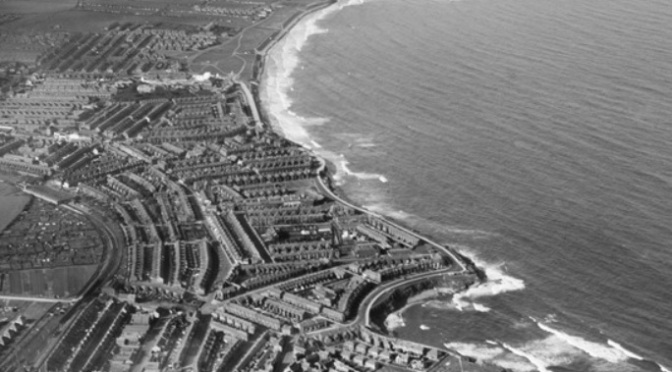Where once a mansion stood in open countryside. The railway and the growth of Whitley Bay as a seaside resort eventually sealed its fate.

Deep beneath the recreational space called Whitley Park, one can hope that the foundations of long-lost Whitley Park Hall might remain. It is hard to imagine that this part of Whitley Bay once looked remarkably different than it does today.
So quiet and peaceful was the scene in the 1860s, that a Newcastle minister, who used to rent the village blacksmith’s cottage in the parish of Cullercoats each summer, was able to practice his sermons on the beach with no-one to disturb him. Whitley-by-the-Sea, or the ‘Dream Village’ as it was frequently called was a long way off becoming Whitley Bay, the popular seaside resort.
Picturesque the village may have been, but apart from its houses of quality which included Whitley Hall, Whitley Park Hall, Whitley House, Marden House and Belvedere House, it boasted only a few farms and terraced cottages with a liberal supply of public houses.

Times changed. The introduction of a passenger train between Monkseaton station and Newcastle put the wheels of progress in motion. The picnicking parties, who had previously travelled from Newcastle by wagonette, began to arrive more frequently and in greater numbers to the little station, where colourful rambling roses grew.
The early history of Whitley had been associated with the Hudson family. Henry Hudson, of Newburn, was one of Cromwell’s Ironsides, the lessee of mills at Billy Mill and Tynemouth and of quarries at Whitley and Monkseaton. He was succeeded by his son, Henry Hudson, the second. Henry Hudson, the third, who married his cousin, Elizabeth Ellison, in 1776, sold 11 acres of land to Edward Hall of Backworth, for the purpose of erecting a brewery here.
Whitley Park Hall, built in white stucco, was constructed by Edward Hall about 1789. He was also a cattle breeder and subsequently added to his estate by the purchase of land from his neighbours. He was famous for being the breeder of ‘The Fat Ox,’ immortalised in one of Thomas Bewick’s copper-plate engravings. The ox chewed the cud in Whitley during the 1780’s, weighing 216 stones, 8 lbs before its slaughter by Newcastle butcher Thomas Horsley in 1789.

On Edward Hall’s death in 1792, it was bought by John Haigh, a ‘hostman’ who became bankrupt in 1797 and moved to America. His assignees sold it in 1800 to Thomas Wright of North Shields, who occupied it until his death in 1840. In 1844, it was bought by John Hodgson-Hinde, and sold in 1855 to Charles Mark Palmer, a shipbuilder then at the height of his fortune, and in 1869 to Thomas William Bulman, who later extended it, diverted the road around his property, and planted a tree belt that still exists today.

Thomas William Bulman died in 1879, and his widow sold Whitley Park Hall in 1893 to Theodore Hoyle, Joseph George Joel, Joseph Aynsley Davidson Shipley and Richard John Leeson, who wished to prevent it from disappearing under hundreds of small houses and hoped that a hydropathic establishment could be opened. Plans for the health facility fell through, but a provisional licence for a hotel and restaurant was granted to the Whitley Park Hotel Company in 1893. It opened in the spring of 1896 under the management of Miss Carrie Sokel. In 1910, the company sold parts of the grounds which were turned into the Spanish City Pleasure Grounds (subject of the Dire Straits song Tunnel of Love, along with Whitley Bay and the nearby town Cullercoats), while other parcels of land were sold off for building purposes.

The house was used for billeting during the Great War but was left with only twelve of its sixty apartments in good condition. The hotel was sold to Whitley Pleasure Gardens Company in 1920, with plans to use its grounds to erect elaborate amusements and shows, as well as a scenic railway, extending from Spanish City. The development faltered, but the hotel was sold to Whitley Bay and Monkseaton Urban District Council in 1924, which used the building as offices. In 1939, it spent £30,000 on new offices in Whitley Park, finding the old house “totally unsafe,” and to be “suffering from galloping consumption.”
Whitley Park Hall was demolished in 1939, and a library was built on the site in 1966, since also demolished.



